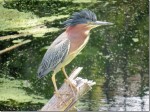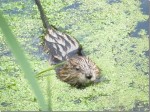
Apparently the badger state is asking for more public input on its very draconian beaver management plan. I want to review it but can see I already wrote about it pretty scathingly in 2011. I’ll repost here, but the two added things I learned by watching the excruciating webinars was that WDNR believes their state is exceptional. Even though trout are helped by beaver dams in the west, it’s different in Wisconsin. Nobody can explain why exactly, but beaver dams and trout CANNOT coexist in the state. So obviously one has to go.
(And you know which one.)
They believe that the beaver population has gone UP since historic times. They actually do a helicopter flyover every three years in the northern part of the state and count beaver sign per square mile. This inflated method has given them an estimate of about 50,000 beavers in the state, or about 100 per square mile of water. Which they say is dreadfully more than it was historically but less than it was before they started killing them.
Oh, and just in case you wondered, history starts in 1900.
The Wisconsin DNR wants to know if it has the right plans for beavers in the state. The final public feedback period is open for the new beaver management plan.
The document will guide decisions on beavers through 2025. The final draft touches on topics like population, habitat, and damage management. The current draft recommends keeping beaver populations mostly stable in the state.
Public input for the final beaver management plan is open through June 22. The DNR will also host a public meeting on June 16 from 6-8 p.m. at the DNR Service Center in Rhinelander to take comments.
That’s right, there’s zero discussion of the native population and how many beaver were there before the fur trade came. Did you know the french were trapping Wisconsin as early as 1600? Gee I wonder how the natives lived off trout before then, with all those icky beavers ruining their creeks and no one to control them. Never mind. Since they’ve been killing beavers in the state the trout population has thrived. Of course it couldn’t be for any OTHER reason. Like water quality regulations for example…
Beaver Management Plan Update Webinar from UWEXNaturalResources on Vimeo.
Yesterday I was ranting at the computer watching the above and this, but today I’m just going to rerun what I wrote 4 years ago on the subject. They obviously learned nothing since then. If you want to give Wisconsin the benefit or your knowledge, your much needed wisdom goes here:
_______________________________________________________________
“The Badger State” has decided to update its beaver policy. See in the 80’s they counted a beaver population of 200,000 and did some research that found that removing beaver dams from streams was the single best thing Wisconsin could do for its trout, so they’ve been doing so at such a great rate that there are only about 80,000 beavers left in the state. Is that too few, they wonder? Did we do TOO good a job? Mind you, they’re review of the policy isn’t prompted by any new reading of the research, or comprehension of the trickle down effect of fewer beavers on wetland ecology – but because (this is a quote, I’m not kidding)
“Certain user groups are concerned that the recreational opportunity provided by beaver is not what they’d like to see,”
“User Groups” as in TRAPPERS. There aren’t enough beaver to enjoyably kill. Maybe we should change our regulations to encourage a few more so that our sporty sportsmen have fewer empty snares. They are busily having meetings with the public to get input about attitudes towards beavers and soothe the ruffled feathers – er, scales – of the Trout Unlimited folk who are certain the beaver mean harm to trout.
Steve Avelallemant, of Rhinelander, is the fisheries supervisor for the DNR’s Northern Region, and he admitted that beaver dams can be a problem, especially on trout streams in northern Wisconsin.
“They (beaver and trout) just cannot exist together for a host of reasons,” said Avelallemant, who helped shape the state’s original beaver plan. “Out West, beavers are a good thing for trout streams. In Wisconsin, not so much.
Beaver and trout just can’t exist together!And since trout are non-negotiable, beavers must be limited! Never mind that up until they were eradicated before the 1800’s the state used to have millions more beaver. Interestingly, before we eliminated the local natives they had lived off plentiful trout streams for 2000 years and never complained of the shortage. Never mind history. Never mind about all that “fancy-pants” research that says beavers are good for trout. This is WISCONSIN. Our streams are different. Our trout are different. We have our OWN research. Just look.
 Well, this looks interesting. Go get some coffee. That’s a pretty long study period. Let’s take a look at what it says, shall we?
Well, this looks interesting. Go get some coffee. That’s a pretty long study period. Let’s take a look at what it says, shall we?
 Okay, no skimming allowed. you HAVE to read this. Beaver dams raise the water temperature, and ruin channels and bring in riff-raff fish that eat up all the insects AND attract wildlife that eat up all the trout. Wow. And most of the research cited is from the Eisenhower era. So we know it must be true.
Okay, no skimming allowed. you HAVE to read this. Beaver dams raise the water temperature, and ruin channels and bring in riff-raff fish that eat up all the insects AND attract wildlife that eat up all the trout. Wow. And most of the research cited is from the Eisenhower era. So we know it must be true.
The study goes on to review several different methods of stream restoration and to compare these methods by region around the state. Marinette county seems to be the segment designated as the no-beaver zone and USDA kindly removed all the dams (and beavers) in these areas. Then the measures were taken again after the streams had time to get used to their new no-beaverness. Guess what! The beaverless streams did better!
 I know I’M excited! Don’t I look excited? I was so excited I wrote them a four page paper in response, which if you’re the kind of person that cares you can read here. In the meantime I will tell you that I got very interested in this particular “region” which was the only part of the study devoted to beaver killing and showing stellar results. Since I’ve read beaver research in the post-Eisenhower period, I was very curious about their findings. I hunted around the internet looking for possible confounding variables – and found that the nearby Menominee River was the proud home of the Ansul chemical company that made Sufur Dioxide and was sued for releasing Arsenic into the water for around 50 years. Around that time of this study the EPA busily was forcing them to clean up the ground water and build protective berms over the poisonous sediment. Hmm.
I know I’M excited! Don’t I look excited? I was so excited I wrote them a four page paper in response, which if you’re the kind of person that cares you can read here. In the meantime I will tell you that I got very interested in this particular “region” which was the only part of the study devoted to beaver killing and showing stellar results. Since I’ve read beaver research in the post-Eisenhower period, I was very curious about their findings. I hunted around the internet looking for possible confounding variables – and found that the nearby Menominee River was the proud home of the Ansul chemical company that made Sufur Dioxide and was sued for releasing Arsenic into the water for around 50 years. Around that time of this study the EPA busily was forcing them to clean up the ground water and build protective berms over the poisonous sediment. Hmm.
Could THAT have anything to do with trout health ya think?
So while I was busy smacking my forehead and reliving the plot of Silkwood, Rick went hunting for data on trout and beaver. He found this lovely restocking guide from the Vermont Fish & Wildlife conservation group. See Vermont’s worried about its native trout too, so they’re encouraging watershed groups to put in some baby ones (called fry) to keep the streams going. They have some GREAT advice about how to do it. Check it out.
 So apparently if you live in opposite ends of the country in Washington or Vermont beaver dams are good for trout. But if you have the misfortune to live in Wisconsin they’re just AWFUL. So awful in fact that only scientific papers from 50 years ago are courageous enough to trumpet their disaster. DNR has a lovely little survey asking for public input on beavers, with searching, unbiased questions like to “how badly do beavers ruin your fishing season? very badly – not sure – or only slightly badly” And “on a scale of 1-5 how much do you dislike beavers when they viciously chew down your trees and flood your property”. Not a push-poll in any way, they are respected scientists! Perhaps a few readers of this website will give that survey the careful responses it deserves.
So apparently if you live in opposite ends of the country in Washington or Vermont beaver dams are good for trout. But if you have the misfortune to live in Wisconsin they’re just AWFUL. So awful in fact that only scientific papers from 50 years ago are courageous enough to trumpet their disaster. DNR has a lovely little survey asking for public input on beavers, with searching, unbiased questions like to “how badly do beavers ruin your fishing season? very badly – not sure – or only slightly badly” And “on a scale of 1-5 how much do you dislike beavers when they viciously chew down your trees and flood your property”. Not a push-poll in any way, they are respected scientists! Perhaps a few readers of this website will give that survey the careful responses it deserves.
How does California feel about beaver dams and trout or salmon? Well Brock Dolman sent this picture yesterday of the fourth annual release of 170 adult Coho into Salmon Creek Watershed in Sonoma County which he made sure to photograph along side a beaver puppet to make his point.
 Could Wisconsin possibly maintain its stubborn position in the face of all this data to the contrary? You know badgers are famous for not giving up even losing battles. Reportedly, their skeletons are sometime found with their jaws still locked together in combat. I guess they don’t call it the “Badger” state for nothing.
Could Wisconsin possibly maintain its stubborn position in the face of all this data to the contrary? You know badgers are famous for not giving up even losing battles. Reportedly, their skeletons are sometime found with their jaws still locked together in combat. I guess they don’t call it the “Badger” state for nothing.
Oh and Happy Solstice, by the way! Since today’s another no burn day you can’t have a fire all night to keep up your spirits on the longest night of the year, but light a candle anyway and dream about new possibilities for beavers coming soon!
 Congratulations Camilla on a very sympathetic article. You are really good at your job, which is apparently three times harder than ours. (WS killed 60000 coyotes nationally, and 22000 beaver).
Congratulations Camilla on a very sympathetic article. You are really good at your job, which is apparently three times harder than ours. (WS killed 60000 coyotes nationally, and 22000 beaver).





















































